
Earl Theisen Walt Disney oiling scale model locomotive at home in LA 1951

Over 9,000 new cases in a single day. It’s been a while, if it ever happened. New deaths are also crawling up. And in most places, we’re just getting started. Things like travel, public gatherings will soon be halted all over. There is no other choice. This virus can survive airborne for 3 hours, and patients can remain contagious for up to 37 days.
Get some extra vit.C, vit.D3 while you can, boost your health, wash more often. And prepare to hunker down for as much as 2 months. It’ll be a different world for a while. Get used to that while you can, while it’s voluntary.
And as you’re settling in, also prepare for a godalmighty financial crash. The Fed yesterday paid a nice round trillion for a 10% fall in stocks. Well, at least Chelsea Manning is free, albeit still in hospital.
• Cases 135,809 (+ 9,165 from yesterday’s 126,644)
• Deaths 4,990 (+ 351 from yesterday’s 4,639)
Apart from China, there are just 2 other countries left in this list that have less than 100 new cases.
From Worldometer yesterday evening (before their day’s close)
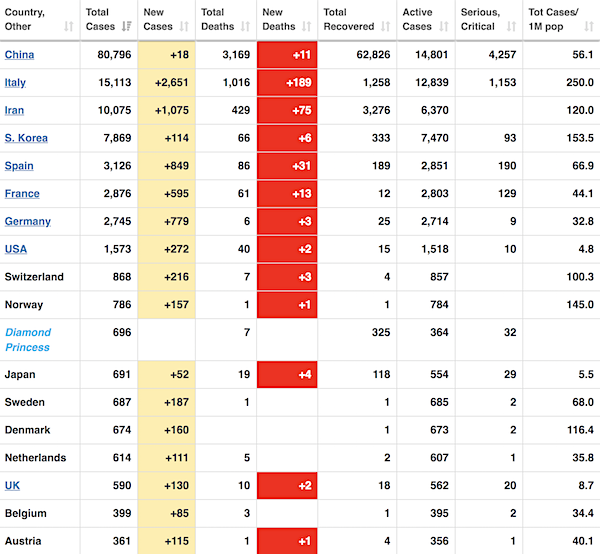
From SCMP: (Note: the SCMP graph was useful when China was the focal point; they are falling behind now)
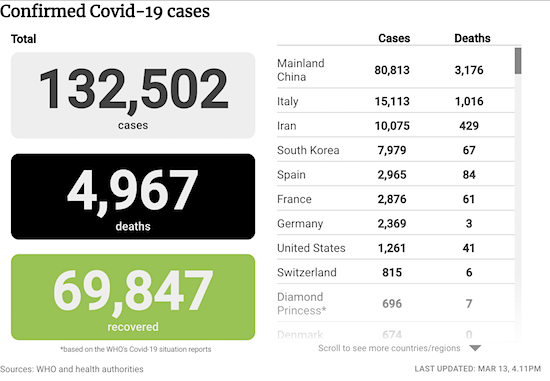
From Worldometer (NOTE: mortality rate is back up to 7%!)
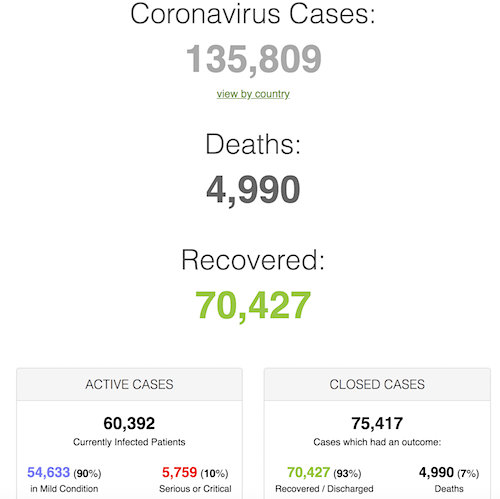
From COVID2019.app: (This site is playing with its formats while expanding, now over 200 global contributors)


“We found that viable virus could be detected in aerosols up to 3 hours post aerosolization, up to 4 hours on copper, up to 24 hours on cardboard and up to 2-3 days on plastic and stainless steel. HCoV-19 and SARS-CoV-1 exhibited similar half-lives in aerosols, with median estimates around 2.7 hours. ”
• Coronavirus Can Survive in the Air For Up To 3 Hours (GR)
Scientists at Princeton University, the University of California-Los Angeles and the National Institutes of Health (NIH) have released a study on Wednesday according to which the novel form of coronavirus can survive in the air for several hours. Federally funded tests conducted by the scientists indicated that the COVID-19 virus could remain viable in the air “up to 3 hours post aerosolization,” while remaining alive on plastic and other surfaces for up to three days. “Our results indicate that aerosol and fomite transmission of HCoV-19 is plausible, as the virus can remain viable in aerosols for 42 multiple hours and on surfaces up to days,” reads the study’s abstract.
The test results suggest that humans could be infected by the disease simply carried through the air or on a solid surface, even if direct contact with an infected person does not occur. That finding, if accepted, would come in stark contrast to previous media reports that suggested the virus was not easily transmittable outside of direct human contact.

I couldn’t find the 37-day figure this Twitter comment mentions, in the report (didn’t copy the writer). That doesn’t mean it’s wrong.
Study in the Lancet finds that #COVID19 viral shedding can be UP TO 37 DAYS, with an average of 20 DAYS. *Patients may still be contagious during that time* VERY BIG DEAL because current guidelines recommend only a 14 day (2 week) isolation time. This means patients may remain contagious well after they’re no longer symptomatic. And it means current guidelines (14 day isolation) may lead to additional propagation post quarantine.
Check the graph for hospital beds per 1,000 people in your country.
• Clinical Course, Risk Factors For Mortality Of Adults In Wuhan (Lancet)
The level and duration of infectious virus replication are important factors in assessing the risk of transmission and guiding decisions regarding isolation of patients. Because coronavirus RNA detection is more sensitive than virus isolation, most studies have used qualitative or quantitative viral RNA tests as a potential marker for infectious coronavirus. For SARS-CoV, viral RNA was detected in respiratory specimens from about a third of patients as long as 4 weeks after disease onset. Similarly, the duration of MERS-CoV RNA detection in lower respiratory specimans persisted for at least 3 weeks, whereas the duration of SARS-CoV-2 RNA detection has not been well characterised.
In the current study, we found that the detectable SARS-CoV-2 RNA persisted for a median of 20 days in survivors and that it was sustained until death in non-survivors. This has important implications for both patient isolation decision making and guidance around the length of antiviral treatment. In severe influenza virus infection, prolonged viral shedding was associated with fatal outcome and delayed antiviral treatment was an independent risk factor for prolonged virus detection. Similarly, effective antiviral treatment might improve outcomes in COVID-19, although we did not observe shortening of viral shedding duration after lopinavir/ritonavir treatment in the current study.
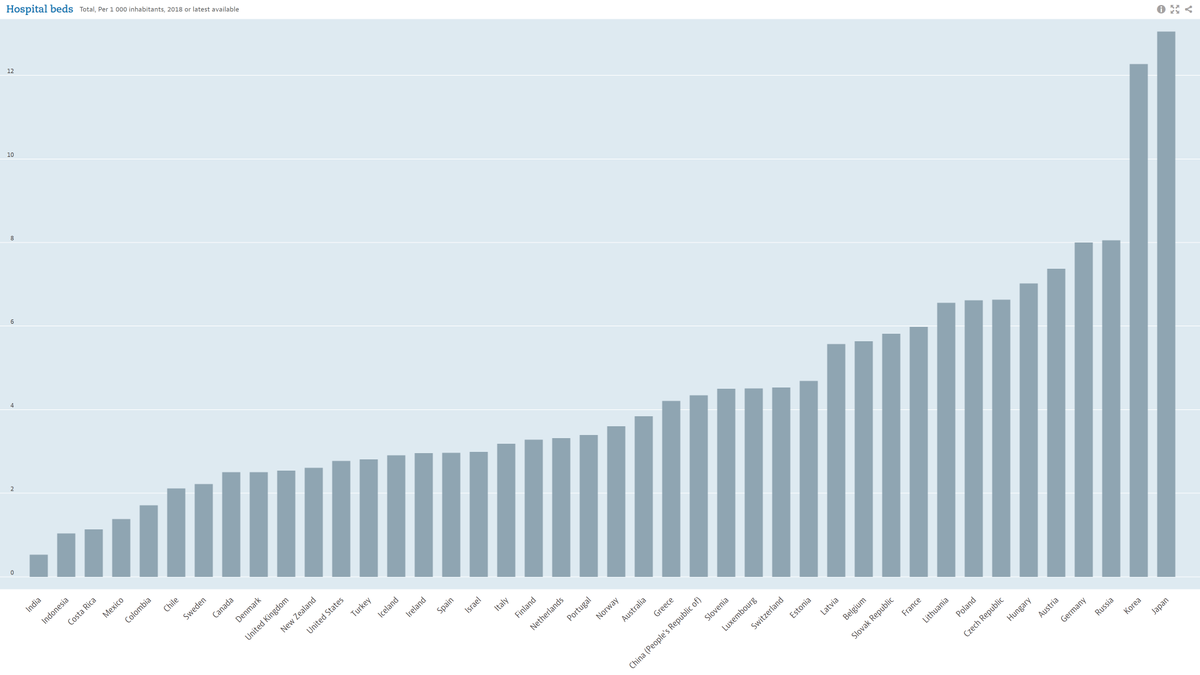
Click for larger version in new tab

When Zhong Nanshan said in late January that the China epidemic would be over in max 10 days, I said he sounded like a Beijing propagandist. He’s still at it.
• Coronavirus May End By June If Countries Take Action – China Adviser (RT)
The deadly outbreak may be over by the start of summer, provided that all countries mobilize themselves against the pandemic, said Chinese government adviser in charge of tackling the coronavirus. Zhong Nanshan, Chinese coronavirus adviser and the epidemiologist who discovered Severe Acute respiratory Syndrome (SARS) in 2003, made the prediction while speaking to journalists on Thursday. He noted, however, that the breakthrough is heavily dependent on how World Health Organization’s (WHO) members are dealing with the crisis. Some countries still don’t take the situation very seriously and fail to aggressively contain the Covid-19, Zhong said. In this case, the epidemic might be prolonged even despite the summer heat that makes viral stains relatively inactive, the doctor warned.
His remarks come shortly after China’s National Health Commission (NHC) reported a decline in new Covid-19 cases across the mainland. “Broadly speaking, the peak of the epidemic has passed for China,” said Mi Feng, a spokesman for the National Health Commission. “The increase of new cases is falling.” As of Wednesday, the NHC recorded 15 new cases, about half as many as Tuesday’s figure. China has been leading a swift response to the disease, locking down whole provinces, canceling public events and even postponing key sessions of parliament. To contain Covid-19, Beijing dispatched around 42,000 medics who flocked to Hubei province – the epicenter of the epidemic – from all across the country. Academics, leading infectionists, and intensive-care specialists were all called in.

“According to a survey of epidemiologists the coronavirus outbreak probably won’t peak before May, meaning it will be getting worse and worse and worse over the next two months, and for much of that time, presumably, exponentially worse.”
• Policymakers Ramp Up Support As Coronavirus Shreds Markets (R.)
Governments and central banks readied more emergency measures to tackle the economic impacts of the coronavirus on Friday as Asian markets suffered their worst weekly crashes since the 2008 financial crisis. Canadian Prime Minister Justin Trudeau’s wife Sophie was among several thousand people newly diagnosed with the COVID-19 respiratory disease that has now infected almost 135,000 and killed more than 4,900 worldwide. Experts warn that due to a lack of testing and unreported cases, many more people may be affected by the outbreak that emerged in the Chinese city of Wuhan late last year. Major sporting events were canceled or postponed, large public gatherings restricted or banned and schools closed. “There is a sense of fear and panic,” said James Tao, an analyst at stockbroker Commsec in Sydney, where phones at the high-value client desk rang non-stop.
“It’s one of those situations where there is so much uncertainty that no-one quite knows how to respond … if it’s fight or flight, many people are choosing flight at the moment.” Japan’s Nikkei was in freefall, dropping 10% on Friday, after Wall Street stocks slumped around 10% in their worst day since the 1987 “Black Monday” crash. Travelers in Europe rushed to board flights to the United States after U.S. President Donald Trump imposed sweeping restrictions on travel from the continent, a decision that angered European leaders and frightened investors. Trump also suggested that the 2020 Olympics in Tokyo could be delayed by a year. “Maybe they postpone it for a year … if that’s possible,” Trump told reporters. “I like that better than I like having empty stadiums all over the place.”
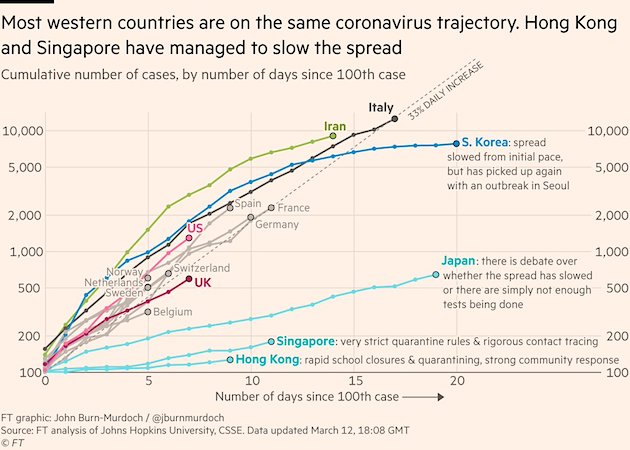

Simple math: “..at the very least, 1 percent of our population is carrying this virus in Ohio today,” Acton said. “We have 11.7 million people. So the math is over 100,000.”
• Ohio Health Official Estimates 100,000 People In State Have Coronavirus (Hill)
A top health official in Ohio estimated on Thursday that more than 100,000 people in the state have coronavirus, a shockingly high number that underscores the limited testing so far. Ohio Department of Health Director Amy Acton said at a press conference alongside Gov. Mike DeWine (R) that given that the virus is spreading in the community in Ohio, she estimates at least 1 percent of the population in the state has the virus. “We know now, just the fact of community spread, says that at least 1 percent, at the very least, 1 percent of our population is carrying this virus in Ohio today,” Acton said. “We have 11.7 million people. So the math is over 100,000. So that just gives you a sense of how this virus spreads and is spreading quickly.”
She added that the slow rollout of testing means the state does not have good verified numbers to know for sure. “Our delay in being able to test has delayed our understanding of the spread of this,” Acton said. The Trump administration has come under intense criticism for the slow rollout of tests. Dr. Anthony Fauci, a top National Institutes of Health official, acknowledged earlier Thursday it is “a failing” that people cannot easily get tested for coronavirus in the United States. Not everyone with the virus has symptoms, and about 80 percent of people with the virus do not end up needing hospitalization, experts say.
During a House committee hearing, Representative Katie Porter does the math on #coronavirus testing, which added up to $1,331, and got CDC Director Robert Redfield to commit to using his authority under federal regulations to waive the cost of testing for all Americans pic.twitter.com/P2R8PjjJMB
— Reuters (@Reuters) March 13, 2020

Boris Johnson doesn’t understand the simple math that Ohio Department of Health Director Amy Acton, above, does. But he still gets vilified for saying that not 500,000 (at the very least!), but just 10,000 are infected.
Maybe it just takes time to sink in?!
Boris also gets vilified for not closing schools, just like Dutch PM Rutte. Which is indeed a little odd: you ban gatherings of more than 100-200 people, but 1500-2000-pupil schools remain open. On the other hand, where would all those children go?
Here’s a thought: Will their phone addictions now save their lives? Kids these days are perfect isolationists. All they need is a screen.
• Many More Families Are Going To Lose Loved Ones Before Their Time (Ind.)
Up to 10,000 people in the UK probably have coronavirus, officials have said, as they announced they were stepping up Britain’s response to the outbreak with new actions designed to delay its spread. Anyone showing cold or flu-like symptoms is being told to isolate themselves for seven days from Friday onwards – a measure brought forward by at least a week. They should then stay at least two metres, or “about three steps”, away from anyone else, sleep alone and ask for help “to get the things you need”. “Stay away from vulnerable individuals such as the elderly and those with underlying health conditions as much as possible,” the new advice reads.
Schools have been ordered to cancel all foreign trips, and elderly people or those with underlying health conditions are advised not to go on cruise ships. However, ministers have stepped back from immediate closures and sporting events will still go ahead, with fans allowed into stadiums. Patrick Vallance, the government’s chief scientific adviser, said the true number of infections was “likely” to be between 5,000 and 10,000 – many times higher than the current figure of 590. “We are in a period when we have got some, but it hasn’t yet taken off,” he told a press conference. The warning came as Boris Johnson sought to prepare the public for tougher times to come, saying: “This is the worst public health crisis for a generation.”
He dismissed comparisons to seasonal flu: “Because of the lack of immunity, this disease is more dangerous and it’s going to spread further. “Many more families are going to lose loved ones before their time.” Explaining the decision not to move to more draconian restrictions now, unlike almost all neighbouring countries, Mr Johnson said: “The most dangerous period is not now but some weeks away, depending on how fast it spreads. He hinted at a likely shift to banning fans from sporting events, saying: “We are not saying ‘No’ to that sort of measure, of course not – we are keeping it up our sleeve.”
https://twitter.com/EdConwaySky/status/1238177127951982594

“I just can’t shake the terror that the United States, my adopted country, is fundamentally unequipped to handle what lies ahead.”
• I’d Rather Be in Italy Than US for the Coronavirus Pandemic (IC)
I have spent the last week looking for flights from New York to Italy — not because of coronavirus-inspired flash sales, but because I would rather go home to a country that’s currently in the grip of one of the worst outbreaks in the world than stay in the United States, where life is about to get infinitely worse. More than 15,000 people have tested positive for the new coronavirus in Italy, more than 1,000 have died, and hospitals are at a breaking point. Hundreds of medical staff have been infected, and overwhelmed doctors are reporting having to choose which patients to treat. They are begging the rest of the world to take this virus more seriously. The entire country — 60.5 million people — has been on lockdown for almost a week.
In the U.S., meanwhile, where some are just starting to realize the enormity of the crisis and far too many remain in denial, confusion reigns, largely aided by our top officials’ inept response. Last night, after President Donald Trump abruptly announced he was blocking travel from Europe to the U.S. — though officials later retracted and clarified much of that statement — people in Europe raced to airports, reportedly paying as much as $20,000 to try to catch flights out. And still I am trying to figure out how to make the opposite trip. Even as the death toll back home continues to climb and the lockdown gets stricter by the day, I would much rather weather this pandemic in Italy than here. I just can’t shake the terror that the United States, my adopted country, is fundamentally unequipped to handle what lies ahead.
[..] It is a tragic irony that a public health emergency unlike anything we have seen in generations would come as Americans are constantly told that the idea of health care as a fundamental right is entitled, radical, crazy talk. What is crazy, to anyone outside the United States, is that it’s even a question. Back in Italy, people are worried they’ll get themselves or their loved ones sick, they are angry at directives that came late, they are even scared that hospitals won’t be able to keep up. But there are more hospital beds and doctors per capita in Italy than there are in the U.S. The Italian government’s harsh restrictions are in part an effort to stop the virus from spreading to the south, where the health care system is weaker. But for all their fears, Italians don’t have to worry that tests won’t be available, or that they’ll have to pay for those tests, or for any of their care. They don’t have to fear that if they seek help now, they’ll get a surprise bill later or that medical costs will bankrupt them.
https://twitter.com/i/status/1237944481153814529

Could we fix health care with that? How much is that per American?
• Fed Rolls Out Fastest Money Printer Ever, up to $4.5 Trillion in 4 Weeks (WS)
Thursday early afternoon, during the chaos when the S&P 500 was down nearly 9%, what would turn into the worst single-day stock market sell-off since the 1987 crash, the Fed rolled out its fastest mega money-printer yet, after its smaller money-printers malfunctioned. It’s not going to be a long-drawn-out QE – though there is a component that is just that – but it’s going to be trillions of dollars, essentially all at once, front-loaded, starting today, though today fizzled already. This is the Fed’s latest effort to bail out Wall Street, the cherished asset holders that are so essential to the Fed’s “wealth effect,” all repo market participants, the banks, and the Treasury market that suddenly has gone haywire. Lots of things have gone haywire as the Everything Bubble unwinds messily.
Last week, the 10-year Treasury yield had plunged toward zero during the stock market sell-off, which was crazy but in line with the logic that investors were all piling into safe assets, and early Monday morning it fell to an unthinkable all-time low of 0.38%. But then, the 10-year yield more than doubled from 0.38% at the low on Monday to 0.88% at the highpoint on Thursday. That the 10-year yield spikes during a stock market crash is somewhat of a scary thought. It means that both stocks and long-dated Treasury securities are selling off at the same time. And that probably made the Fed very nervous. For stocks, Thursday was the 16th trading day since the S&P 500 peak, and in those 15 trading days, the index has crashed nearly 27%.
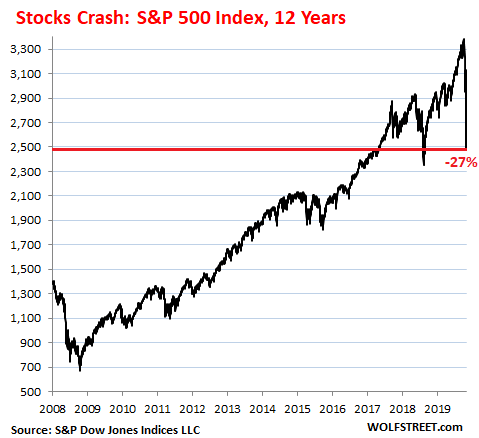

Inject a trillion, see markets lose 10%. Never a better moment to end the Fed.
• Fed To Pump In More Than $1 Trillion Into Markets In Dramatic Move (CNBC)
The Federal Reserve stepped into financial markets Thursday for the second day in a row and the third time this week, this time dramatically ramping up asset purchases amid the turmoil created by the coronavirus. “These changes are being made to address highly unusual disruptions in Treasury financing markets associated with the coronavirus outbreak,” the New York Fed said in an early afternoon announcement amid a washout on Wall Street that was heading toward the worst day since 1987. Stocks were off their lows following the announcement though some of the gains were pared as the market digested the moves.
One part of the announcement saw the Fed widen the scale for its $60 billion worth of money the Treasury purchases, which to now had been confined to short-term T-bills. Under the new regime, the Fed will extend its purchases “across a range of maturities” to include bills, notes, Treasury Inflation-Protected Securities and other instruments. The central bank will begin purchasing coupon-bearing securities, something market participants have been clamoring for since late 2019. The purchases start Thursday and will continue through April 13.
The second part of the new operations will see the New York Fed desk offer $500 billion in a three-month repo operation and a one-month operation. The offerings will happen on a weekly basis through the remainder of the program. In addition, the Fed will continue to offer at least $175 billion in overnight repos and $45 billion in two-week operations. Repos are short-term operations in which financial institutions provide high-quality collateral in exchange for cash reserves they use to operate.

“This is their tool. They’ve used it. It should be working”…
• Market Turmoil Sparked By Coronavirus Fears Worse Than 2008 – Bianco (CNBC)
Market researcher James Bianco calls the Federal Reserve’s move to pump $1.5 trillion into the market the “nuclear option” to calm investors gripped by coronavirus fears. Only, it didn’t work Thursday. Instead, stocks saw their worst day since the 1987 Black Monday market crash. “Financial markets are not recovering. It’s incredible to think that a trillion dollars can’t get these markets moving,” the Bianco Research president told CNBC’s “Trading Nation.” “We’re at a critical time — unlike anything I’ve seen in my career even counting 2008.” On Thursday, the Fed attempted to stabilize the markets by massively boosting asset purchases in the market. It came five days before its policy meeting on interest rates.
“What the Fed did was they restarted QE, and they essentially announced that in the next two days they’re going to do more QE than they did in the last five years combined,” added Bianco. “The reason they’re doing it is because the financial markets have stopped functioning properly. There’s no liquidity. There’s hardly any trading.” Stocks initially rebounded, but failed to hold on to gains. The Dow sank 2,352 points or 10% to 21,200 while the S&P 500 fell 261 points or 9.5% to 2,480. The Dow and S&P are deep in bear market territory, off 28% and 27%, respectively, from their all-time highs. “This is their tool. They’ve used it. It should be working”, said Bianco.
According to Bianco, Wall Street may still be in shock due to the magnitude of the Fed’ s move. Plus, he suggests there may be logistical issues. [New York] Governor [Andrew] Cuomo just announced that any gathering of over 500 people in New York State is banned. So, these big dealer desks are now going to have to figure it out from home, he said. “If financial markets don’t start moving, and if a trillion dollars cannot get them off the lows of the day of $500 billion today, $500 billion tomorrow, then we’re going to have to start worrying that a panic is going to set in… and we’re going to see a lot more losses as we go forward,” Bianco said.
Only 16 days ago that the U.S. stock market was at record highs. The fastest time between a new high and a bear market in history.
The old record was set in 1929, when it took 42 days over in Sept/Oct to drop into a bear market.
Never good to breaking a record set in 1929! pic.twitter.com/5vAtHbzLQn
— Jim Bianco (@biancoresearch) March 12, 2020

I love you long time.
• Apple Reopens All Its Branded Stores In China (R.)
Apple has reopened all 42 of its branded stores in China, more than a month after they were shut due to fears over the coronavirus outbreak, the iPhone maker’s Chinese website showed on Friday. Apple’s China website has listed the opening time for all stores, which vary from 10:00 am to 11:00 am local time. The website had previously carried an advisory saying not all stores were open. China placed curbs on travel and asked residents to avoid public places in late January, just ahead of the Lunar New Year festival, a major gift-giving holiday. Those restrictions stayed largely in place through most of February. The company sold fewer than half a million iPhones in China in February, government data showed on Monday, as the outbreak halved demand for smartphones. Apple had announced the shuttering of its branded stores in early February.

Something tells me prices may have just gone up.
• US Excludes Some Chinese Medical Products From Tariffs (R.)
The U.S. Trade Representative’s office said it granted on Thursday exclusions from import tariffs for some medical products imported from China, including face masks, stethoscope covers and blood pressure cuff sleeves. The exclusions were granted as the United States grapples with a coronavirus outbreak that threatens to strain its healthcare system. Earlier this month, USTR granted exclusions for other Chinese medical products, including hand sanitizing wipes and examination gloves.
The products were included in a fourth round of tariffs on Chinese goods imposed by President Donald Trump on Sept. 1, 2019, amid heated U.S.-China trade negotiations. The tariff rate on the medical products was initially set at 15%, but was lowered to 7.5% on Feb. 15 as part of the Phase 1 U.S.-China trade agreement. The deal leaves in place tariffs on about $370 billion worth of imports from China, including 25% duties on goods valued at around $250 billion.

IMF meets sanctions x world health.
• Iran Asks IMF For $5 Billion Emergency Funding To Fight Coronavirus (R.)
Iran has asked the International Monetary Fund (IMF) for emergency funding to help it fight the coronavirus outbreak that has hit the Islamic Republic hard, Foreign Minister Mohammad Javad Zarif said on Thursday. The escalating outbreak in Iran – the worst-affected country in the Middle East – has killed 429 people and infected 10,075. The outbreak has damaged Iranian businesses and is bound to hit its non-oil exports after many neighboring countries and trade partners shut their borders. The IMF managing director, Kristalina Georgieva, “has stated that countries affected by #COVID19 (coronavirus) will be supported via Rapid Financial Instrument. Our Central Bank requested access to this facility immediately”, Zarif said in a tweet.
Iranian Central Bank chief Abdolnaser Hemmati wrote on his Instagram page that “in a letter addressed to the head of IMF, I have requested five billion U.S. dollars from the RFI emergency fund to help our fight against the coronavirus”. Iran’s economy was already battered by U.S. sanctions that curb oil and gas exports crucial for government revenues. A slowdown in economic activity caused by the virus outbreak and a sustained closure of its borders are expected to lead to a contraction this year, analysts have said. As Iran’s clerical rulers struggle to contain the coronavirus outbreak, Tehran has blamed the United States and its “maximum pressure” policy for restricting Iran’s ability to respond effectively to the virus.
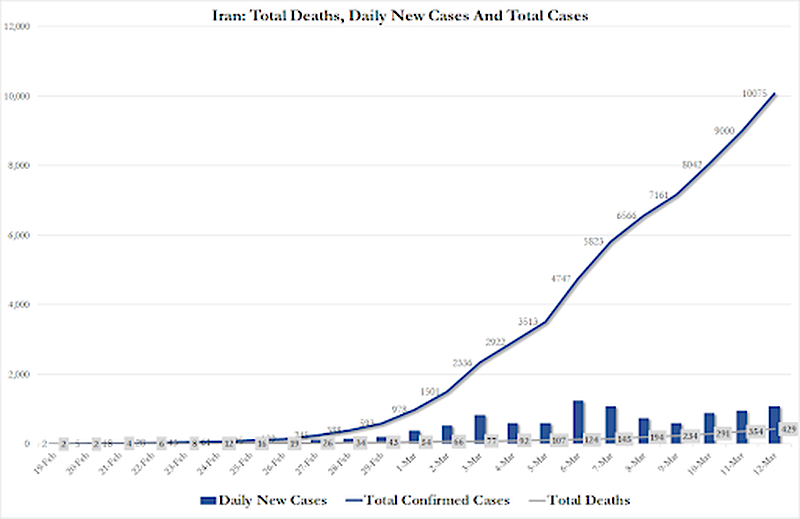

Bit right wing for me, but interesting.
• Greening Our Way to Infection (CJ)
The COVID-19 outbreak is giving new meaning to those “sustainable” shopping bags that politicians and environmentalists have been so eager to impose on the public. These reusable tote bags can sustain the COVID-19 and flu viruses—and spread the viruses throughout the store. Researchers have been warning for years about the risks of these bags spreading deadly viral and bacterial diseases, but public officials have ignored their concerns, determined to eliminate single-use bags and other plastic products despite their obvious advantages in reducing the spread of pathogens. In New York State, a new law took effect this month banning single-use plastic bags in most retail businesses, and this week Democratic state legislators advanced a bill that would force coffee shops to accept consumers’ reusable cups—a practice that Starbucks and other chains have wisely suspended to avoid spreading the COVID-19 virus.
John Flanagan, the Republican leader of the New York State Senate, has criticized the new legislation and called for a suspension of the law banning plastic bags. “Senate Democrats’ desperate need to be green is unclean during the coronavirus outbreak,” he said Tuesday, but so far he’s been a lonely voice among public officials. The COVID-19 virus is just one of many pathogens that shoppers can spread unless they wash the bags regularly, which few people bother to do. Viruses and bacteria can survive in the tote bags up to nine days, according to one study of coronaviruses. The risk of spreading viruses was clearly demonstrated in a 2018 study published in the Journal of Environmental Health.
The researchers, led by Ryan Sinclair of the Loma Linda University School of Public Health, sent shoppers into three California grocery stores carrying polypropylene plastic tote bags that had been sprayed with a harmless surrogate of a virus. After the shoppers bought groceries and checked out, the researchers found sufficiently high traces of the surrogate to risk transmission on the hands of the shoppers and checkout clerks, as well as on many surfaces touched by the shoppers, including packaged food, unpackaged produce, shopping carts, checkout counters, and the touch screens used to pay for groceries. The researchers said that the results warranted the adaptation of “in-store hand hygiene” and “surface disinfection” by merchants, and they also recommended educating shoppers to wash their bags.

I admit, included for the headline.
• Two Angry Old Men Yelling at Each Other in Arizona (FPM)
Bernie’s got a problem. He’s struggling in the delegate count and Florida and New York are unlikely to help. He’s got one way to reverse the tide, and that’s destroy Biden in a debate. Destroying Biden is not so hard. He’s a confused and shambling wreck. Even Kamala Harris was temporarily able to pick up some of his voters that way. The trouble is Bernie is nearly as much of a mess. If his people weren’t complete psychos, they might have been able to build an alliance with Elizabeth Warren. Instead, all the bridges were burned, and Sanders benefited little from her dropping out. But Warren, staying in, could have served as Bernie’s hatchet woman. So might Tulsi Gabbard, though she last served as Biden’s hatchet woman.
But considering that she’s polling at nothing, there’s no pretext that could get her into the debate. And Bernie is a poor debater. Not as much as Biden, but close enough. All he can do is respond to every question with an angry rant about corporations and medical care. That’s not going to win anything. After Biden’s victory speech, it’s clear that the current brains behind his campaign have been able to get him to memorize his own speeches and deliver them in an angry tone that passes for energy. That’s Bernie’s shtick. And it’s probably not a coincidence. So the Arizona debate will consist of two old men angrily yelling at each other with stump speeches. Sounds like a winner.

Upside down world: “..the loss of glyphosate would cause very severe impacts on UK agriculture and the environment..”
• Monsanto’s Secret Funding For Weedkiller Studies (G.)
Monsanto secretly funded academic studies indicating “very severe impacts” on farming and the environment if its controversial glyphosate weedkiller were banned, an investigation has found. The research was used by the National Farmers’ Union and others to successfully lobby against a European ban in 2017. As a result of the revelations, the NFU has now amended its glyphosate information to declare the source of the research. Monsanto was bought by the agri-chemical multinational Bayer in 2018 and Bayer said the studies’ failure to disclose their funding broke its principles. However, the authors of the studies said the funding did not influence their work and the editor of the journal in which they were published said the papers would not be retracted or amended. Glyphosate is sold by Bayer as Roundup and is the world’s most widely used weedkiller.
The World Health Organization’s cancer agency, the IARC, declared that glyphosate was “probably carcinogenic to humans” in 2015 but several international agencies, including the European Food Safety Authority (EFSA), subsequently came to opposite conclusions. Last year courts in the US ordered Monsanto to pay damages of up to $2bn to individuals with cancer and faces many more lawsuits. Bayer said it “stands fully behind its glyphosate-based products”. The new revelations centre on studies published in 2010 and 2014 by researchers at ADAS, an agricultural and environmental consultancy in the UK. The analyses concluded “the loss of glyphosate would cause very severe impacts on UK agriculture and the environment”. They suggested a 20% fall in wheat and rapeseed production.

You blow up their home and then you toss them a handout to go back to that home.
• Migrants On Greek Islands To Be Offered €2,000 To Go Home (G.)
Migrants on the Greek islands are to be offered €2,000 (£1,764) per person to go home under a voluntary scheme launched by the European Union in an attempt to ease desperate conditions in camps. The amount is more than five times the usual sum offered to migrants to help them rebuild their lives in their country of origin, under voluntary returns programmes run by the United Nations’ International Organization for Migration (IOM). The offer will last one month, as the commission fears an open-ended scheme would attract more migrants to Europe. It will not apply to refugees who have no homes to return to, but is intended to incentivise migrants seeking better living standards to leave the islands.
The EU’s home affairs commissioner, Ylva Johansson, said the scheme was “a window of opportunity for a targeted group”, adding that the IOM would run the scheme with the EU border agency Frontex. “Refugees will not return, of course, they can’t return, but economic migrants that maybe know they will not get a positive asylum decision could be interested in doing that,” she told a small group of reporters. The scheme, she said, could be a quick way to relieve the pressure on camps on the Greek islands, where conditions are “totally unacceptable”. The commission said it hoped 5,000 people will take up the offer, although it acknowledged it lacked statistics on how many people on the Greek islands were “economic migrants”, rather than refugees.
Migrants on the Greek mainland were likely to be offered extra money to leave – much less than €2,000, but higher than the usual resettlement sum of €370. Since 2016, 18,151 people have chosen to return home from Greece under a voluntary returns programme funded by the EU and run by the IOM. Only about one-fifth of them (3,927) were on the islands. [..] More than 20,000 people are living at the Moria camp on Lesbos, up from 5,000 last July. About 85% of last year’s arrivals were refugees, with most coming from Afghanistan and Syria, but also from Iraq, Palestine, Somalia, the Democratic Republic of the Congo and elsewhere. More than 18,300 Moria residents were living in a facility designed for 2,200, while others were living in nearby olive groves.

” Judge Anthony Trenga did not waive the $256k in penalties levied against her.”
• Judge Orders Immediate Release Of Chelsea Manning (Ind.)
A US judge has ordered the immediate release of Chelsea Manning, the former American army officer who was remanded to prison after refusing to testify against WikiLeaks. The ruling states that it is no longer necessary for her to testify and follows her attorneys’ announcement that she had recently tried to kill herself while imprisoned. She is reportedly recovering in hospital. Ms Manning spent seven years in a military prison after leaking thousands of classified government documents to WikiLeaks before Barack Obama commuted her sentence in 2017. Last year, she was held in contempt of court after refusing to testify before a federal grand jury as part of an investigation into Julian Assange and WikiLeaks. She has been jailed since May.
In his ruling on Thursday, Judge Anthony Trenga did not waive the $256k in penalties levied against her. The ruling says that enforcement of the “accrued, conditional fines would not be punitive but rather necessary to the coercive purpose” of the court’s contempt order. She was scheduled to appear at a hearing in a Virginia federal court today. That appearance has been cancelled.

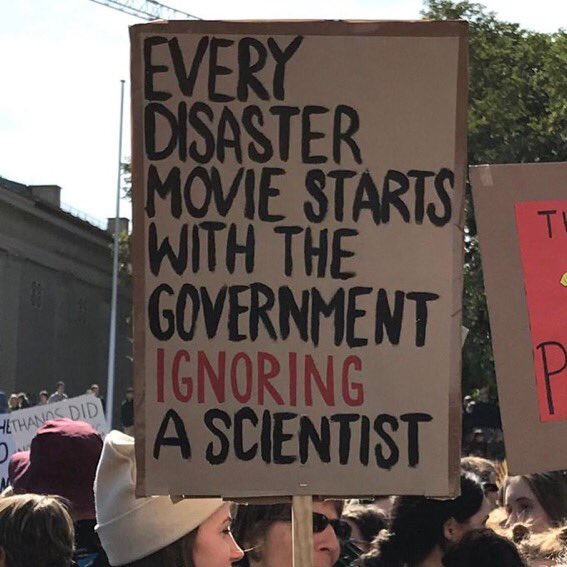

If you read us, please support us. Help the Automatic Earth survive.







